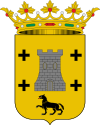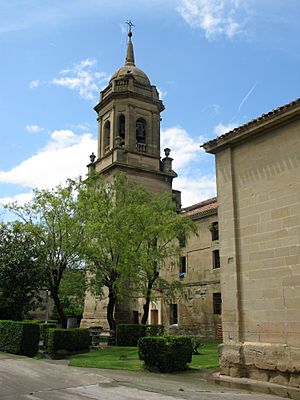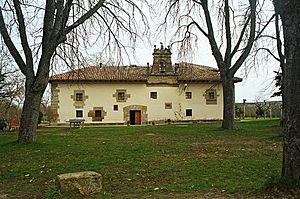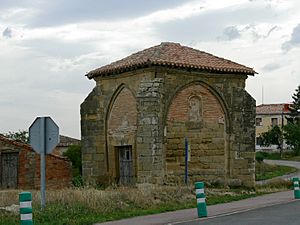Grañón facts for kids
Quick facts for kids
Grañón
|
||
|---|---|---|

Church of San Juan Bautista
|
||
|
||
| Country | ||
| Autonomous community | ||
| Comarca | Santo Domingo de la Calzada | |
| Area | ||
| • Total | 31.01 km2 (11.97 sq mi) | |
| Elevation | 725 m (2,379 ft) | |
| Population
(2018)
|
||
| • Total | 255 | |
| Demonym(s) | grañonero, ra | |
| Postal code |
26259
|
|
Grañón is a small village in La Rioja, Spain. It is located in the western part of the region. The village covers about 31 square kilometers and had a population of 255 people in 2018.
Most people in Grañón work in farming and raising cattle. Many young people move to Logroño, the capital of La Rioja, to find other jobs.
Contents
Exploring Grañón's Nature
Grañón is in the westernmost part of La Rioja, right on the border with the Province of Burgos. The area has forests, mountains, and rolling hills.
Water can be scarce, especially in hot summers. Most of the land is used for farming, mainly for growing cereals like wheat. You can also find large potato fields and some other crops like peas and beans.
What Plants Grow Here?
Grañón has two main forest areas: Monte Carrasquedo and Monte Alto.
Monte Carrasquedo is a flat, natural area to the south. It has many common and Pyrenean oak trees. You can also find maple, almond, and wild cherry trees. Two types of pine trees, Pinus sylvestris and Pinus radiata, grow here too.
Around the trees, there are many bushes like hawthorn, heather, and wild rose. You might also spot oregano and wild marjoram.
Monte Alto is a smaller forest. It is mostly filled with beech and Pyrenean oak trees. Among the beech trees, you can find anemones, violets, and holly. In the oak areas, juniper, heather, and ferns grow.
What Animals Live Here?
Grañón's diverse landscape is home to many animals.
You can often see birds like the coal tit, chaffinch, and woodpecker. Jays live among the pine trees, and robins can be found in clearings. Birds of prey, such as goshawks and sparrow hawks, fly overhead. Black kites are often seen in open spaces.
Squirrels are common because of the many trees. You might also spot field mice, wild boar, foxes, and badgers. For reptiles, green lizards and common wall lizards are present. Vipers are sometimes seen depending on the season.
Grañón's Past: A Look at History
Grañón has a long history, dating back to the 9th century.
Around 885, King Alfonso III ordered a castle to be built on a nearby hill. This castle, called Mirabel, helped protect Christian lands from attacks. Over time, small villages grew around the castle, and more people settled in the area. Grañón also had hospitals, like the Hospital of Carrasquedo, which helped travelers.
Grañón was involved in battles between the kingdoms of Navarre and Castile in the 11th century. In 1176, King Henry II of England helped settle a dispute over Mirabel Castle. Grañón's castle stayed with Castile. In 1187, the village received a special law (a fuero) that helped plan its growth.
The village became more important when Domingo de la Calzada changed the route of the Camino de Santiago (a famous pilgrimage path). The new route passed through Grañón, bringing more life to the town.
Grañón used to have protective walls, but they are gone now. As the village grew, the castle became less important. The fertile land around Grañón has led to many disagreements over the years. The most famous story is the Leyenda de los Valientes (Legend of the Brave).
The Legend of the Brave
Many centuries ago, Grañón and the nearby town of Santo Domingo argued over a large piece of land called La Dehesa. Both towns believed the land belonged to them. The arguments often turned into fights.
To end the conflict, both towns agreed to choose one person to fight for the land. The winner would claim La Dehesa for their town. The fighters would be unarmed.
Santo Domingo chose a skilled fighter. Grañón chose Martín García, a simple farmer who ate caparrones (red kidney beans).
On the day of the fight, Martín García bravely picked up his opponent and threw him far away. Martín García won La Dehesa for Grañón!
Every August, people from both towns gather at the Cruz de los Valientes (Cross of the Brave) to remember this legend. They leave flowers for Martín García and eat caparrones. A local singer, Juancho Ruiz el Charro, even wrote a song about the legend.
Art and Architecture in Grañón
Grañón has a rich history of art and buildings, especially because of its connection to the Camino de Santiago.
Town Layout and Old Buildings
The old part of Grañón grew around the San Juan monastery (which is now the main church). It has four main streets: Calle La Parrilla, Calle Santiago, Calle Mayor, and Calle El Caño. Other streets cross these.
You can see traditional houses in the older streets. Most houses have two floors. The bottom floor is made of stone, and the top floor uses wood and brick. Many old houses have family coats of arms on their walls. The oldest houses date back to the 16th and 17th centuries.
Grañón's oldest square is Plaza de la Iglesia, built in the 17th century. Later, Plaza del Hórreo and Plaza de Ávila were opened.
The village also has old sinks and fountains that people still use today. There are two old lavoirs (washing places) where women used to wash clothes. One dates back to the 18th century. The other is next to the Basque pelota court and includes a fountain from the 1860s.
The fountain in Plaza de Ávila was built in 1926. It used to be a drinking spot for animals. Today, it's a decoration in a garden. A new stone fountain was built in Plaza del Hórreo as a tribute to pilgrims.
Important Religious Buildings
Grañón has several important religious buildings that show its history. Many old monasteries and chapels have disappeared over time. Today, the main ones are the Church of San Juan Bautista, the Chapel of Nuestra Señora de Carrasquedo, and the Chapel of the Jews.
Parish Church of San Juan Bautista
This church is in the center of town. It has a long main hall (a nave), a special area for the altar (a chancel), and a unique back section (an apse). The tower is made of stone. The church was built between the 15th and 16th centuries, with later additions like the sacristy and tower.
Inside, you can see a baptismal font from the 12th century. This is the only part left from the original monastery. The main altarpiece, dedicated to Saint John, is very detailed. It was built between 1545 and 1556 and shows many moving sculptures. This beautiful piece was restored in 1993.
The church is a "Site of Cultural Interest" in Spain. It is a popular stop for pilgrims on the Camino de Santiago because of its history and art. It also has a well-known hostel for pilgrims.
Ermita de Carrasquedo (Chapel of Carrasquedo)
This chapel is about 1.5 kilometers south of Grañón, surrounded by a forest. An old hospital used to be here. The current building is from the late 17th century and has a Baroque style.
It has one main room with a dome over the center. The main altarpiece inside is also Baroque and was restored in 1989. Outside, there is an entrance with an arch and a bell tower. An image of Our Lady of Carrasquedo, the patron saint of Grañón, is in the center.
Ermita de los Judíos (Chapel of the Jews)
This chapel has a covered crossing that used to guide pilgrims. It is located at the edge of town where several roads meet.
Inside, there is a cross on a stone column. The chapel's name comes from an old altarpiece that showed Jesus being mocked by Jews. This altarpiece was restored and is now in the parish church. The Chapel of the Jews is usually closed, except on Good Friday. On this day, a traditional procession starts here.
Famous People from Grañón
- Count García Ordóñez (c. 1060–1108): A powerful Castilian nobleman, also known as "García of Grañón." He was an important figure during the reign of King Alfonso VI. He helped settle people in La Rioja. He died in battle defending the king's son.
- Don Sancho de Grañón (11th–12th century): A monk and a friend of Saint Dominic of Silos. He became a bishop and helped strengthen the church's power in the region. A street in Grañón is named after him.
- Martín García (mid-14th century): The brave farmer from the "Legend of the Brave." He won the disputed land for Grañón. He is honored every August with a special meal of caparrones at the Cruz de los Valientes. A street in Grañón is named after him.
- Don Agustín Morquecho Alonso del Valle (1788–c. 1850): A priest from an important Grañón family. He was very involved in improving his hometown and La Rioja. He worked to make La Rioja an independent province.
- Juancho Ruiz, el Charro (born 1958): A Spanish singer, writer, and music producer born in Grañón. He works in many music styles, including mariachi and country.
Festivals and Traditions
Grañón celebrates several festivals throughout the year.
- Fiesta de la Virgen de Carrasquedo (March 25): A mass is held at the Chapel of the Virgin of Carrasquedo, followed by outdoor dancing.
- May 1: The Virgin of Carrasquedo is carried in a procession from her chapel to the Church of San Juan Bautista. She stays there all summer. People dance to traditional music along the way. Saint John the Baptist comes out to meet her, and they recite poems. The next Sunday, the Virgin is paraded through town to bless the fields.
- Saint John and Saint Juanito (June 24 and 25): On Saint John's Day, bonfires are lit, and people dance. Early the next morning, decorated carriages are pulled through the streets, waking people up. Locals often offer pastries and drinks.
- Fiesta de Gracias (Festival of Thanksgiving) (Last week in August): This festival gives thanks for the harvest. The Virgin is returned to her chapel for the winter. On the last day, a traditional dish called patatas a la riojana is prepared near the chapel.
- Caparrones at the Cruz de los Valientes (mid-August): This event remembers Martín García's victory in the "Legend of the Brave." People from both Grañón and Santo Domingo meet at the cross to offer flowers and enjoy caparrones.
Grañón also has a street market every Wednesday where you can buy various products.
Community Groups
Grañón has important community groups that help with town life:
- The Association of Friends of the Chapel of Carrasquedo: This group organizes activities, especially during Cultural Week in August. They publish a magazine called Mirabel three times a year, sharing interesting stories about Grañón.
- The Martín García Association of the Elderly
- The Women's Association of Grañón
For young people, the Cuatro Cantones club organizes activities in August, like games for children and sharing choricillo (a small type of chorizo).
See Also
 In Spanish: Grañón para niños
In Spanish: Grañón para niños







